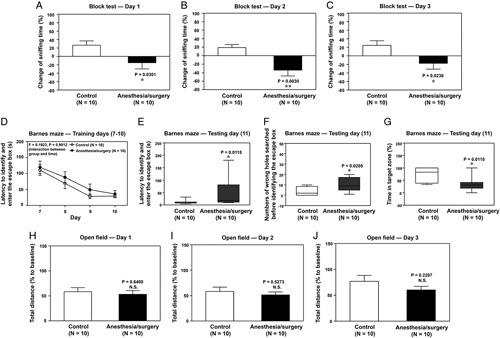FIGURE 2.

Anesthesia/surgery impairs olfactory and cognitive function in mice. Effects of anesthesia/surgery on olfactory function detected by block tests 1 (A), 2 (B), and 3 (C) days after the anesthesia/surgery. (D) Effects of anesthesia/surgery on latency to identify and enter the escape box on Barnes maze training days 7–10 days after anesthesia/surgery. Effects of anesthesia/surgery on latency to identify and enter the escape box (E), numbers of wrong holes searched before identifying the escape box (F), and time in the target zone (G) on Barnes maze testing day (day 11 after anesthesia/surgery). Effects of anesthesia/surgery on total distance in the open-field test 1 (H), 2 (I), and 3 (J) days after anesthesia/surgery. ANOVA, analysis of variance; SEM, standard error of the mean. N=10/group. Data are presented as means±SEM. The Student t test was used to analyze the data in A, B, C, H, I, and J; P values refer to the difference in sniffing time or total distance between the control condition and anesthesia/surgery. Data are presented as means±SEM, and 2-way ANOVA and post-hoc analysis with Bonferroni was used to analyze the data presented in D; P value refers to the interaction of treatment (control vs anesthesia/surgery) and time (days 7–10) on latency to identify and enter the escape box. Data are presented as the median and interquartile range (25%–75%). Mann-Whitney U test was used to analyze the data in panels E, F, and G; P values refer to the difference in behavioral changes between control and anesthesia/surgery groups. *P value <0.05; **P value <0.01.
